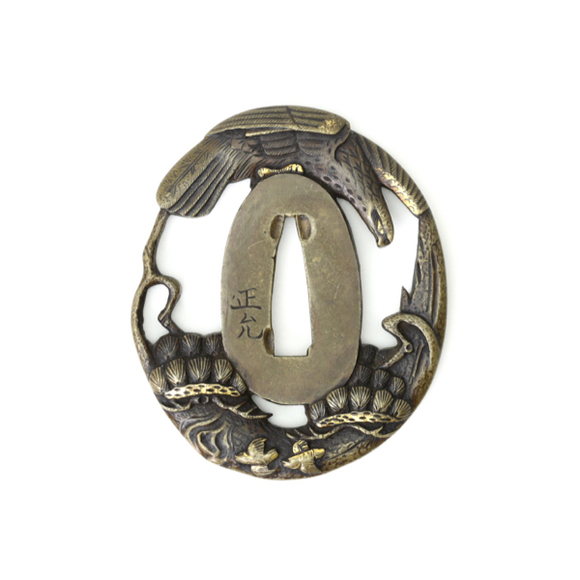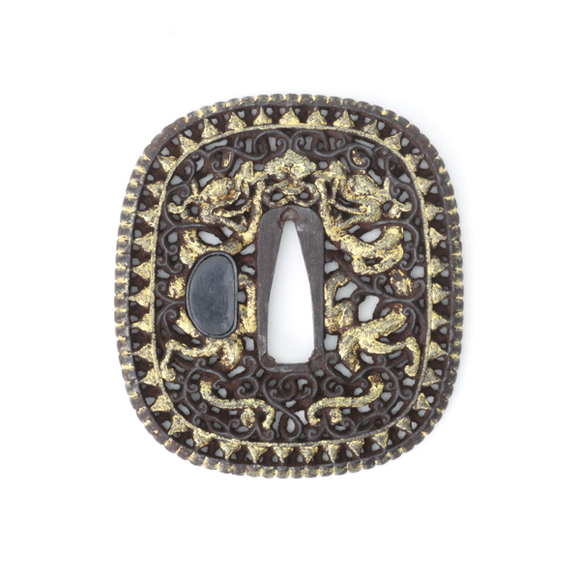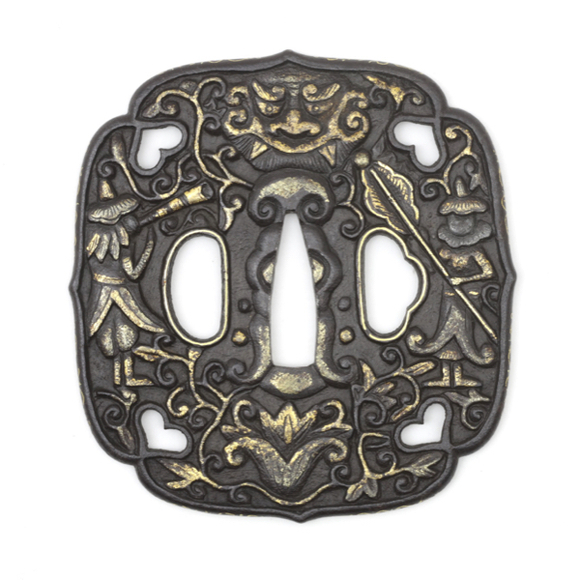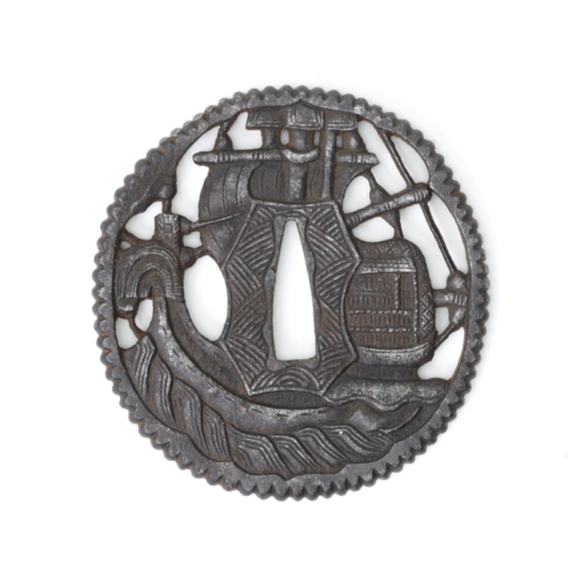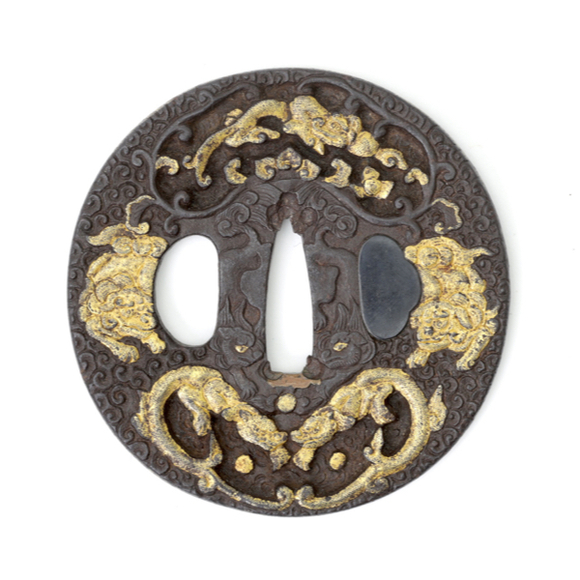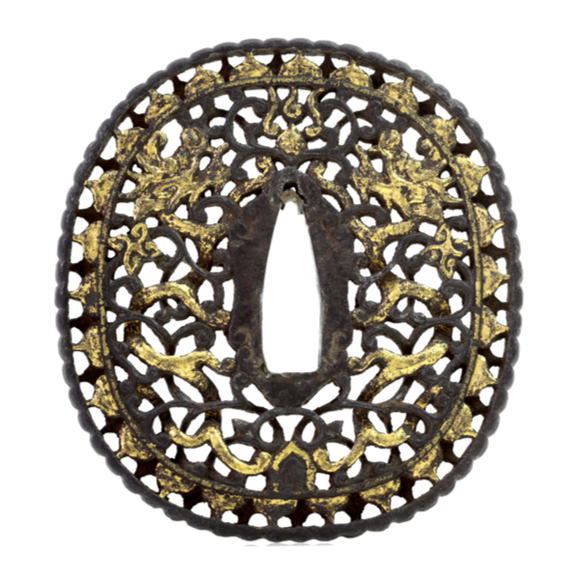Introduction
Sword guards and other sword accessories classified as nanban ("southern barbarian") exhibit foreign designs or motifs.
Among these, signed works are scarce. The reasons are probably three-fold. Japan, at the time, was the only culture where sword parts were often signed by their maker, and many of these items were not made in Japan, or by Japanese workers, to begin with. They are what we would call "Asian export sword guards." The ones made in Japan were often copies of unsigned, foreign prototypes. And lastly, many were mass-produced goods of a quality that no maker would sign.
Here follows an overview of a few rare signed examples that help us get a handle on who produced what, and when. But let's begin with the "usual suspects": Hirado Kunishige, the Yagami carvers, Umetada, and Nagasaki Chinatown work.
1. Hirado Kunishige
Possibly the most famous maker of foreign-inspired styles was the Hirado-based workshop of Kunishige. From the 16th to 18th centuries, the island was frequented by Portuguese, British, Chinese, Korean, and Dutch traders, some of whom were granted trading posts on the island. It was also a known base for the Chinese pirate armies of the mighty House of Zheng, a pirate army so powerful that instead of fighting him, the Ming government made their leader Zheng Chenggong a prince in exchange for protection.
Little has been written about Kunishige but the first generation is thought to have been active around the Kyōho period, (1726-1736).1
The work was usually done in copper alloy, but shakudō and even iron examples are also known. The style of Kunishige reflects the multi-cultural mix that was Hirado.
One of the few historical mentions of this maker is in the Sōken Kishō (装剣奇賞) of 1781, Volume 4:
"Kunishige (国重) – Signatures with the reference “Hirado-jūnin” (平戶住人, “resident of Hirado”) exist. It is also said that there exist signatures of the type “Keishi Kunishige” (京師国重, “Kunishige, old capital of Kyōto”), but more details are unknown, and it is possible that these signatures are forgeries.
Worked in brass, copper, shibuichi, and other materials. He was the first to engrave Dutch-style dragons and similar motifs. His works can be regarded first-class." 2
The dragons are, of course, Chinese style, but at the time, Dutch style was used as a blanket term to cover most things foreign.
For more information, see my glossary article: Hirado Kunishige.
Notes
Haynes H 03650.0.
1. Fukushi Shigeo; Tosogu Classroom. Volume II. Translation by Markus Sesko. Page 520.
2. Inaba Michitatsu; Sōken Kishō (装剣奇賞) of 1781. Translation by Markus Sesko.

平戸
Hirado
國重造
Kunishige tsukuru
N.B.T.H.K. Hozon
Author's collection
2. The Yagami school
The Yagami (矢上) school was located in a suburb of Nagasaki. Starting in the 18th century with first-generation Mitsuhiro, his younger brother as the second generation, and his son as the 3rd generation. They worked mostly in iron, which they carved expertly.
Active periods:
Mitsuhiro I was active circa 1750-1800.
Mitsuhiro II lived from 1748-1823.
Mitsuhiro III lived from 1800-1870.
Their designs took inspiration from Chinese dragons and art motifs. The school is famous for its designs with many monkeys, referred to by collectors as "1000 monkeys," and works with other animals such as hares and shrimp are also known. Mitsuhiro I already pioneered the 1000 monkeys design, but the finer, more complex work was done by Mitsuhiro II.
Notes
Haynes H 05200.0, 05201.0, 05202.0.

肥州矢上住
Hishū Yagami ju
"Resident of Hishū, Yagami"
光廣
Mitsuhiro
The Yagami school trained several artists, among which Hattori Yoshitsugu, who studied under the school's founder Noda Mitsuhiro. Below is a rare replica of a Chinese sword guard by Hattori Taira Yoshitsugu. He faithfully copied the rectangular seppa-dai and modeled the hitsu-ana as if it was cut open as an afterthought, something that was customarily done on imported guards. Yoshitsugu was also known to have made the 100 monkeys style tsuba and also worked in the Satsuma Oda style.
Notes
Haynes H 12231.0.

新七
Shinshichi
Published in Joly, Soshankenshu, #189
Now in the James McElhinney collection
Hattori Yoshitsugu, in turn, was the teacher of Onitake Toshiyoshi, who worked in Nagasaki and Hagi. Signed examples of him are in the James McElhinney collection and the Peabody Essex Museum, Massachusetts.

長崎住
Nagasaki ju
"resident of Nagasaki"
思武利吉
Onitake Toshiyoshi
James McElhinney collection

Related: a fine kozuka. Carved iron over brass.
N.B.T.H.K. Hozon attribution to Yagami, but probably more precisely attributable to Onitake Toshiyoshi.
James McElhinney collection
3. Umetada armillary sphere tsuba
The Umetada school was founded in the late 16th century by Umetada Myōju (埋忠明寿). He was a leading figure in the Shintō sword movement, making blades and fittings in Kyoto. Second in this line was Umetada Tachibana Shigeyoshi, who moved to Nishijin in the north of Kyoto, where he got inspired by European designs and technology. He made several tsuba that depict clocks, European armillary spheres, and European art motifs. One such armillary sphere tsuba is dated 1608.1
There is also a sword blade bearing his name and the date 1628.
Notes
Haynes H 08573.0.
1. Markus Sesko; Geneologies of tsuba makers. Page 24. The one dated 1608 came from the Henri Vever collection, who purchased it at Sotheby's in 1972. It was then in the Edward Wrangham collection and sold again at Bonhams in 2011, lot 52. Another from the Pabst collection was sold at Christies in 2007, lot 239.

城州西陣住
Joshu Nishijin-jū
"Resident of Yamashiro Nishijin"
埋忠橘重義
Umetada Tachibana Shigeyoshi
Author's collection.
4. Nagasaki Chinatown
Nagasaki was at some point home to some 20.000 Chinese, living in Nagasaki's Toujin Yashiki (唐人屋敷), literally "Tang-man Palace," or Chinatown. They were not sitting still. Signed works are rare but a few have turned up over time.
The work is usually relatively flat plates carved in low relief, with no openwork. Often there is overlay in silver and/or gold, and the execution varies from extremely fine to somewhat coarse. It are the finer ones that tend to be signed. The intended market was probably traders who went into Japan on trade or diplomatic missions, and brought these exotic-looking tsuba as suitable gifts.
Notes
James L. McElhinney; Chinese carvers working in Japan during the Edo Period. (Part 1 and 2) Connoisseur's Notebook. 2017.

珠見
Shubai
Pronounced Zhūjiàn in Chinese, meaning “Pearl clam."
N.B.T.H.K. Hozon stating the artist is Chinese.
Haynes; 0.08805.0.
Private collection.

舎貝
Shakai
Pronounced Shèbèi in Chinese, meaning "Mussel"
Published in Fukunaga Suiken; Hizen no Katana To Tsuba, 1974. Volume 1.

賏亲
Onoya
Pronounced Yìngqīn in Chinese, meaning the "originator of a string of pearls."
Author's collection.
The first character is a little worn, and could perhaps also be 唄亲, Japanese: Baioya, Chinese: Bàiqīn, meaning "chanting ancestor". Another possible reading is 睍亲, Chinese: Xiànqīn or "google-eyed ancestor". I chose 賏亲 as the most likely because all others are shell-related names.
Other signed nanban style tsuba
Here follows an overview of some other signed works encountered in this style. Many are from Hizen province, which contained the trade port of Nagasaki. The capital city of Kyoto in Yamashiro province was also a popular production center.
Hizen; Kanesada
A treasure ship tsuba with a tiny signature on the rim of the hitsu-ana. Signed: "Hishū Kanesada", Hishū is an old name for Hizen.
Kanesada appears in the Haynes index, H 02535.0. Active circa 1800, he did classic Canton style with facing dragons and a jewel. He also did the Yagami-style 100 monkey designs.
Examples are published in the Furukawa collection, pl. 22, #122. Wakayama; Tōsō Kinkō Jiten, page 122, upper #7. Wakayama; Tōsō Kodōgu Meiji Takei, Vol. III, page 318. Ken'ichi Kokubo; Shinsen Kinkō Meikan, page 68.
Also signed "Hizen-jū Kanesada" (肥前住兼定).1
Notes
Haynes H 02535.0.
1. Markus Sesko; Signatures of Japanese Sword Fittings Artists. Page 120.

肥州 兼定
Hishū Kanesada
Sold by Mandarin Mansion in 2022.
Hizen, Nagasaki; Yamada Genshō
Rare all-brass Nanban style tsuba signed Kiyo noju Yamada Genshō, where Kiyo is an old name for Nagasaki. This maker is not in the standard literature, however there is mention of a Yamada Ichirohei working in Nagasaki in the second half of the 18th century.1
Notes
Not in Haynes index.
1. Okabe Kakuya; Japanese sword guards. Bostom Museum of Fine Arts. 1908. Page 55.

崎陽住
Kiyo ju
山田玄昇
Yamada Genshō
Gift of James L. McElhinney to the Metropolitan Museum.
Metropolitan Museum, accession number 2017.737.1.
Hizen; Onitsuka Kyurobei
A sword guard by a rare Hizen maker who signed "Hizen soju Onitsuka Kyurobei." (鬼塚九郎兵衛).
Notes
Haynes H03749.0
A similar tsuba is in Terada and Fukunaga; Hizen no Katana no Tsuba, vol 2, page 304.
Discussed on the Asian Export sword guards and Nanban tsuba Facebook page.

Hizen soju
Onitsuka Kyurobei
James McElhinney collection
Yamashiro; Masahisa
A small tsuba with carved dragon and foliage in low relief, without piercing. It came with a matching fuchi on this o-tanto.
Notes
Haynes H 04037.0.

山城國住
Yamashiro kuni ju
"Resident of Yamashiro"
正久
Masahisa
Came with a Shimosaka o-tantō, sold by Mandarin Mansion in 2022.
Yamashiro, Kyoto; Karaku Naoshige
An unusual, deeply carved piece depicting two facing dragon carp. It refers to a Chinese legend of carp swimming upstream through the mythical dragon gate and becoming a dragon. A story of reward after perseverance against incredible odds.
It is signed "Naoshige, resident of Karaku." Karaku is an area in the east of Kyoto. This maker does not appear in the standard literature.

芲洛住
Karaku Ju
"Resident of Karaku"
直茂
Naoshige
Author's collection.
Yamashiro, Kyoto; Ichinomiya Tsunenao
Unusual copper alloy tsuba signed Tsunenao. Student of Nagatsune of the Ichinomiya school in Kyoto. Also signed Sadanaka (貞中).
The style with Western script on the rim reminds strongly of Hirado Kunishige, down to the smaller circles in the O's in the rim. It features the addition of green and red enamel, and a Western year in gold, 1759.
Notes
Haynes H 10869.0
Markus Sesko; Signatures of Japanese Sword Fittings Artists. Page 577.

常真
Tsunenao
Alexander Moslé collection. Published in 1909.
Bonhams 2008, lot 5141.
Yamashiro, Kyoto; Yamashina Sadayoshi
Sadayoshi was also a student of Ichinomiya Nagatsune. The following piece is clearly inspired by the tsuba above or the same template; only the Western date got lost in translation. The reverse appears to be copied directly from a Hirado Kunishige piece. It is executed in shakudō, a rarer material for this style.
Yamashina is in the north of Kyoto.
Notes
Haynes H 07905.0.

山科住
Yamashina ju
定義
Sadayoshi
Offered on eBay, 2022.
Chiryūken
Of unknown origin, his only known work is a set of tsuba, kozuka, wari-kogai and fuchi-kashira that was in the Behrens collection. Stylistically it is of the same school as Hirado Kunishige and the Nanban works of some of the Kyoto Ichinomiya school exponents.
Notes
Haynes H 00313.0.
Henri L. Joly; The W.L. Behrens Collection. Part III. Page 55 & plate XXIII.

池柳軒制
Chiryūken seisu


W.L. Behrens Collection
Sold in London, 1912
Edo Tomoyasu
Iron tsuba with foreign figures, and flowers, decorated with silver overlay, gold damascening, and enamel. It bears a long signature stating Ryūrinsai Tomoyasu, resident of Tokyo. A work dated 1855 is known. Haynes suspects these are 19th-century replicas of much older Nagasaki-style tsuba.
Notes
Haynes H 10166.0.
Henri L. Joly; J.C. Hawkshaw Collection. Page 22 & plate XIX.

東都住
Tōkyō ju
柳林齊友保
Ryūrinsai Tomoyasu
Pauline and Martin Alexander Collection.
Sold at Sotheby's in 2014, lot 22.
Chōshū, Hagi; Kawaji Tomokatsu
During the Edo period, Hagi was the center of power of the Chōshū domain, ruled by the Mōri clan. It was a bustling town of traders, fishermen, and craftsmen.
Here is a tsuba with Southeast Asian style scrolling vines made at Hagi by a maker called Kawaji Tomokatsu who was active circa 1700.
Notes
Haynes 09923.0
Chōshū Kawaji school, Church Collection, Ashmolean.
Asian Export sword guards and Nanban tsuba facebook page.

長州萩住
Chōshū hagi jū
Resident of Hagi, Chōshū
河治友勝
Kawaji Tomokatsu
James McElhinney collection
Masanari
Iron openwork tsuba, notable for being both signed and dated. The maker's name is Masanari and the date given corresponds to 1770 AD.
Notes
Haynes index H 04292.0. Shows a personal seal (kao), but no other information is given.

明和七寅
Meiwa nana tora
(7th tiger year of Meiwa)
正成作
Masanari saku
Provenance: Bonhams, March 2015, lot 3198.
Now in the James McElhinney collection
Tamagawa Yoshihisa Saku
Iron tsuba with dragons, signed Tamagawa Yoshihisa Saku. Several generations Tamagawa Yoshihisa were active, starting with the 18th-century retainer of the Daimyo of Mito. Remaining in Mito for the first few generations, the line later moved to Edo where the last Tamagawa Yoshihisa passed away in 1882. Their typical work is shakudō nanako based and so this may be a false signature.
Notes
Haynes H 11642.0 - 11646.0.

玊川养久作
Tamagawa Yoshihisa Saku
Provenance: Aoi Japan.
Makers in the literature
Apart from the illustrated examples, some others are mentioned in the literature.
Okabe Kakuya mentions production centers in Nagasaki, Kyoto and Yedo (Edo) from the early 18th century onwards.1 Cheap, ready-made goods shiiremono were made principally at Aidzu.2
Generally speaking, we may say that the majority of tlie Namban tsuba, and particularly of the best specimens, come from Hizen in Kiushu and from Nagasaki and Hirado in particular, whilst many shiiremono and some good pieces- were produced in Yecdo, Kioto, Osaka and Sakai.2
Hizen
Nagasaki:
Yamada-Ichirohei1
Second half 18th century.
Hōrinshi (鳳林子)*
Signed "Hizen Nagasaki-jū Hōrinshi" (肥前長崎住鳳林子).
Late Edo, Nanban and Jakushi styles.3
Shigetsugu (重次)*
Signed "Shigetsugu horu" (重次彫)
Late Edo, Nanban style. Possibly affiliated to Shigetada (重忠).
Toshiyoshi (利吉)*
Signed "Onitake Toshiyoshi" (鬼武利吉)
Late Edo, Nanban style.
Higo
Muneharu (宗春)*
Signed "Muneharu" (宗春)
Late Edo. Nanban style.
Yedo (Edo)
Tanaka-Sōbei, early 19th century.2
1. Okabe Kakuya; Japanese sword guards. Bostom Museum of Fine Arts. 1908. Page 55.
2. C.R. Boxer; European influence on Japanese fittings 1543-1853. Transactions & proceedings of the Japan Society, London, Vol 28. Pages 151-178. 1931.
*. Markus Sesko; Signatures of Japanese Sword Fittings Artists.


